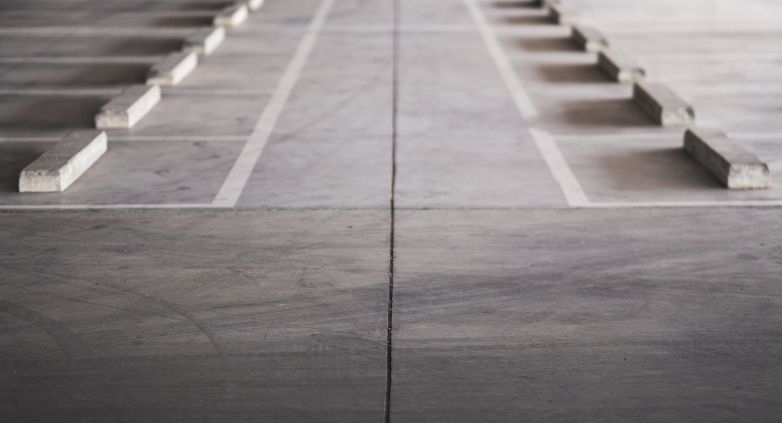Concrete Parking Stops Installation – Quick and Simple
Concrete Parking Stops Installation – an essential step in creating a safe, efficient parking experience for homes and businesses. Discover their significance in enhancing parking lot safety and order.
Concrete parking stops play a crucial role in maintaining order and safety in parking lots. They guide vehicles, ensuring orderly parking and preventing accidents by creating a barrier between parking spaces, walkways, and structures. Installing these stops is vital for protecting vehicles, pedestrians, and property, contributing to a positive first impression and a safer environment for visitors, customers, and staff.
Learn more about the practical benefits of concrete parking stops, installation techniques, and how they contribute to a safer, more organized parking area for your property.
5 Steps to Install Concrete Parking Lots
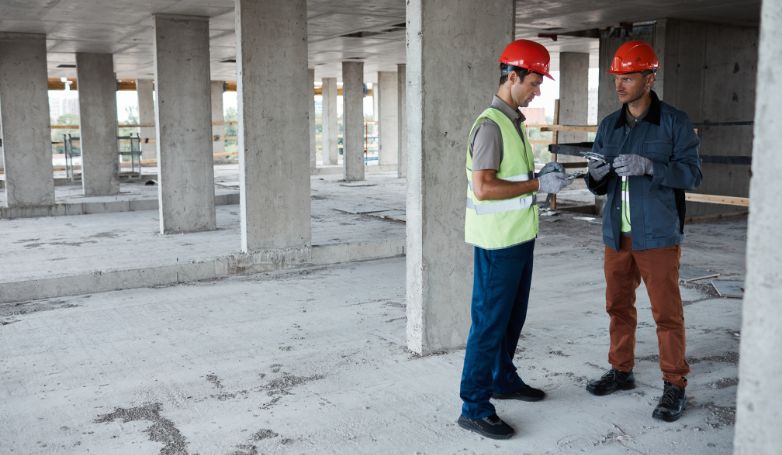
You can install concrete parking lots’ stops (once they have been built) with Lag Bolts & Anchors following the below steps:
- Place the parking stop in the spot where you want to mount it.
- Use a high-speed hammer drill to drill (a 4″ to 4 1/2″) deep hole in the concrete with a 3/4″ masonry bit at each specified place.
- Use a hammer to attach a lag anchor (with the wide round hole drilled into the anchor pointing up) into every hole.
- Shift the parking stop such that the holes you drilled pair up upwards with the molded-in holes.
- Place the wedge bolts into the parking block via the holes and screw up the bolts with a 3/4′′ socket. Complete the tightening of each bolt until cozy.
1. Positioning the Stop
Start by accurately placing the concrete parking stop at the intended spot in your parking lot. This initial positioning is crucial as it dictates the final location of the stop. Ensure it’s aligned correctly with the parking space boundaries and at a suitable distance from walls or pavement edges to accommodate vehicle sizes and parking patterns.
2. Drilling Holes
Use a high-speed hammer drill equipped with a 3/4″ masonry bit to drill holes into the concrete at each marked location. The holes should be 4″ to 4 1/2″ deep to ensure a secure anchor. Precision is key in this step to ensure that the holes align perfectly with the mounting points on the parking stop.
3. Inserting Anchors
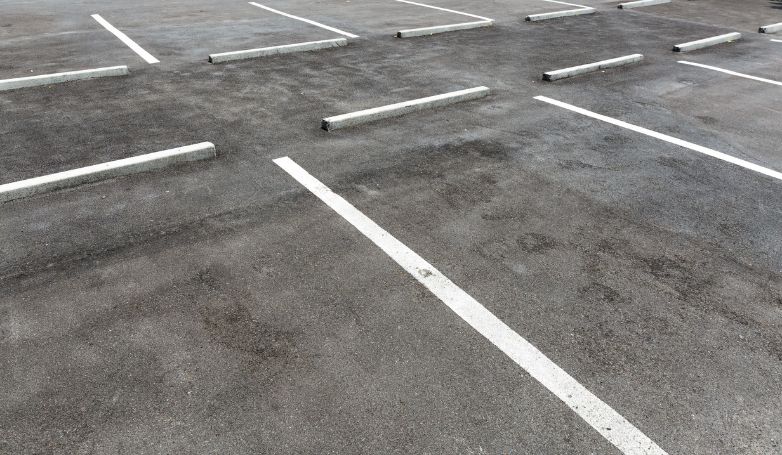
Insert a lag anchor into each drilled hole. The anchor should have a wide round hole facing upwards for securing the bolts. Use a hammer to firmly set each anchor into place. This step is vital for creating a strong foundation for the parking stop, ensuring it stays securely anchored and can withstand the wear and tear of daily use.
4. Aligning the Stop
Carefully shift the parking stop so that the holes drilled in the concrete align perfectly with the molded-in holes on the parking stop. Proper alignment is essential to ensure the parking stop is mounted straight and in the correct position. This step requires attention to detail to ensure the stop will be effectively secured in the next step.
5. Securing with Bolts
Place wedge bolts through the aligned holes of the parking block and into the anchors in the concrete. Using a 3/4″ socket, tighten each bolt until it is snug and secure. This final step solidifies the parking stop’s position, ensuring it is firmly attached to the ground and capable of withstanding the pressures of parked vehicles and environmental factors.
Important Considerations when Installing Concrete Parking Stops
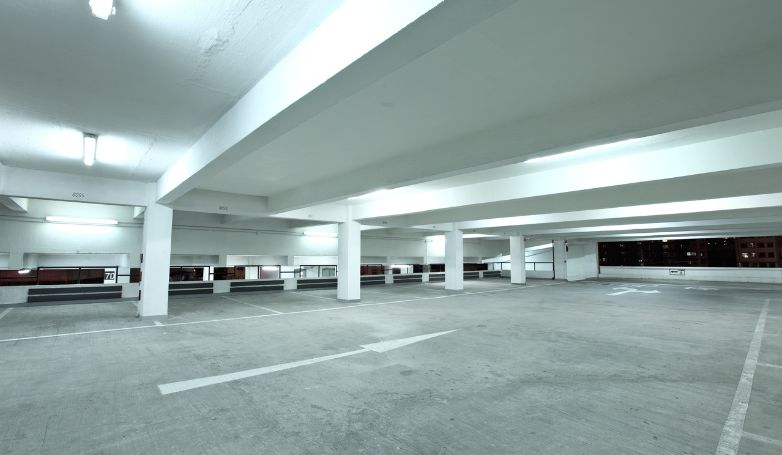
Ensuring a successful installation of concrete parking stops requires careful consideration of various factors. Below are important considerations that play a crucial role in the process
DIY Challenges
If you intend to handle the installation yourself, you may find it challenging and time-intensive due to the heavy weight of concrete. It’s not just that; they typically need a specialized tool like lifting slings to put them in place.
Distance and Orientation
First, you will need to estimate the critical distance from the pavement or wall to the stop and consider whether the park is labeled as rear-in or front-in. Concrete parking stops installation requires the right tools and equipment. You will be needing tools such as fixing pins or screw bolts to fix the stops in place and a drill with the correct masonry bit.
Surface-Specific Installation
You will also require some epoxy to add to the holes of the drill if you want to install it on an asphalt or gravel surface.
These concrete slabs are weighty since they weigh at least 100 lbs. Each parking stop would require 2 to 3 individuals to have it installed. This can tend to be time-intensive in a parking lot with at least 50 spaces. Heavy equipment could be needed to ship and install all parking stops required in a bigger facility with hundreds of parking spaces.
It’s a daunting process, and you’re going to be needing appropriate tools and equipment to have them installed and the help of skilled installers, or at least many people who can assist you.
Are concrete parking stops suitable for your parking lots?
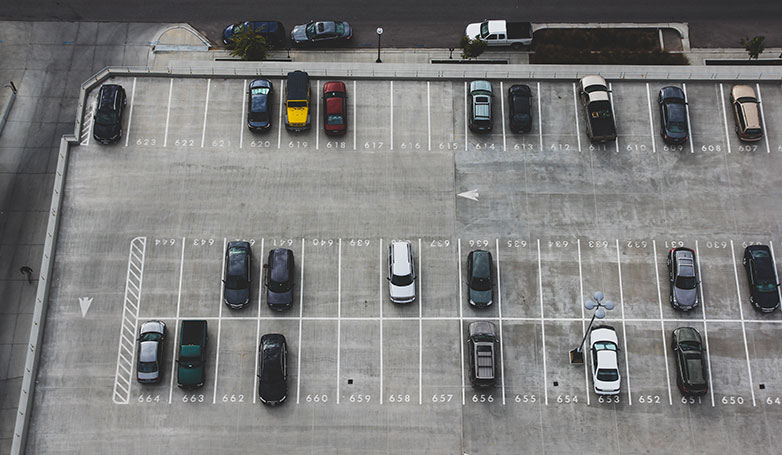
Concrete parking stops are recommended for every parking area due to their significant advantages. They can be laid both outdoors and indoors. One big pro of concrete stops is that they are heavier compared to other materials. As a result of this, they are very robust and can do a very fantastic job of restricting vehicles from moving beyond their allocated parking spaces once set in place.
What are parking stops?
Parking stops are also referred to as parking blocks, wheel stops, or truck stops. They are commonly found in parking lots, rental garages, medical facilities, shopping areas, and some other facilities providing temporary and lengthy parking to keep vehicles from going above their assigned parking space, preventing damages or injuries.
Parking stops are an important safety feature for community parking lots, hospitals, college campuses, churches, office parks, shopping malls, etc. Parking stops are dependent on, in tightly populated, head-on parking centers, to restrict drivers from moving into sidewalks or other parked vehicles.
Versatile protection
It is often used to protect fixed items, such as garbage containers, shopping carts, utility poles, and signs. Parking stops are placed as obstacles for pedestrian walkways, sidewalks, and motorcycle lanes, offering extra protection from moving vehicles.
Concrete parking stops installation is well recommended for every parking lot-at home or business for safety purposes. Although there are other types of parking stops available, concrete stops are commonly used due to their durability and flexibility.
Why does your lot need parking stops?
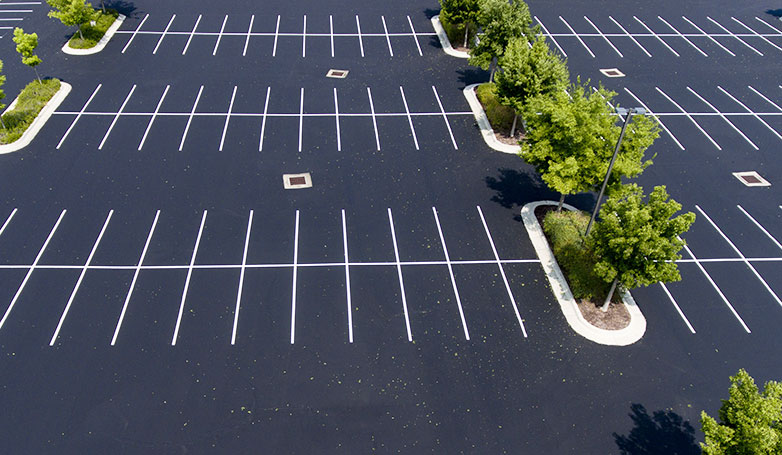
Below are the reasons why your lot needs parking stops:
- They help to prevent fender benders in your lot
- They help to boost traffic flow
- They help to improve your commercial parking lot’s overall appearance
Parking stops are necessary for all parking lots to mark the parking area’s boundary and protect landscaping from vehicle intrusion. They are needed in a highly dense parking lot.
They help to prevent fender benders in your lot
Parking stops are installed in lots to restrict cars from parking on sidewalks or other restricted areas. They prevent drivers from pulling through parking spots or trying other dangerous movements by physically restricting a vehicle’s wheels.
This helps to prevent houses, roads, fragile landscapes, and other vehicles from being damaged. In addition, concrete parking stops installation is necessary as they can protect other motorized vehicles (like forklift trucks) when working in warehouses and factories.
They help to boost traffic flow
As a property owner, there is a high probability that your parking lot will always be busy, especially during rush hours of the day. This involves both staff and customers driving in-and-out of the facility. Parking stops are required to organize your parking lot in the most effective way to help direct the flow of traffic while observing both state and federal safety codes.
It helps to improve your commercial parking lot’s overall appearance
Customers highly value the aesthetic importance of a well-operated and well-maintained parking lot. A perfect way to improve the overall appearance of your parking lot is to add parking stops. Parking stops are typically used for enclosing parking lots and help preserve the look of your parking lot landscape.
Other common types of parking stops
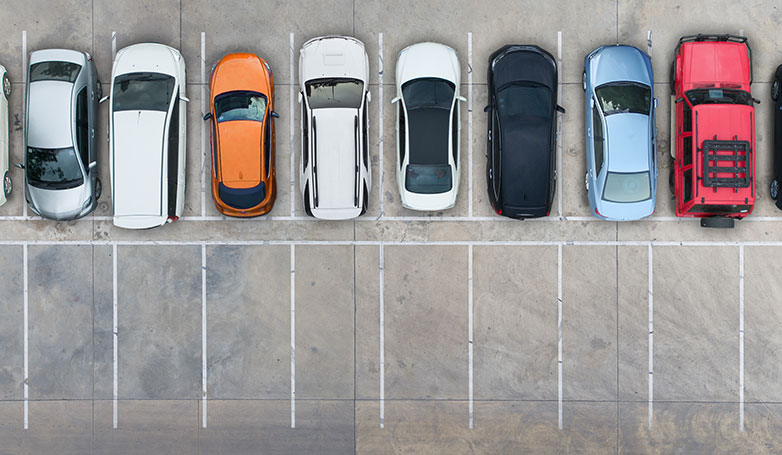
Below are other common types of parking stops to consider:
- Rubber Parking Bumper
- Plastic Parking Stop
- Metal Bollard
It is vital to consider customers’ safety, whether you have a single row of parking spots or a separate lot for your commercial property. Also, you have to consider your building’s safety. Parking stops are perfect if you consider making your lot or storefront more convenient. Below are other common types of parking stops to consider:
Rubber Parking Bumper
Most businesses today prefer rubber parking bumpers since they are easy to fit with asphalt, which most companies use as a pavement option to improve the look and also save money. Rubber parking bumpers are more efficient than some alternatives because recycled tire rubber is usually made from them.
A rubber parking bumper is also malleable and is less likely to be broken or cracked. They have less weight than concrete stops. This makes their installation very easy. Although concrete parking stops installation is still a preferred choice for most people, they are more sturdy and last longer.
Rubber parking bumpers are robust enough to prevent slow-moving cars from moving too far forward. However, if they lack translucent paint or the paint disappears, they can not be as easy to see.
Plastic Parking Stop
The main drawback of this option is that plastic is not eco-friendly. Many businesses, however, are making reliable parking stops from recycled plastic. One advantage of choosing plastic is that it is cost-effective. Also, the installation of plastic stops is effortless enough that one person would generally do it alone. They are parking lot fixtures with low maintenance, and they are extremely resistant to chemicals and severe weather conditions.
Metal Bollard
Metal security bollards resemble that of small/thick poles that project from the ground. One benefit of bollards is that they are easily visible, and you can use reflective paint to coat them for enhanced night vision. It is more costly to use high-quality steel bollards in individual parking spaces. They are, however, perfect for putting on corners or row ends in a lot.
How Are Concrete Parking Stops Made?
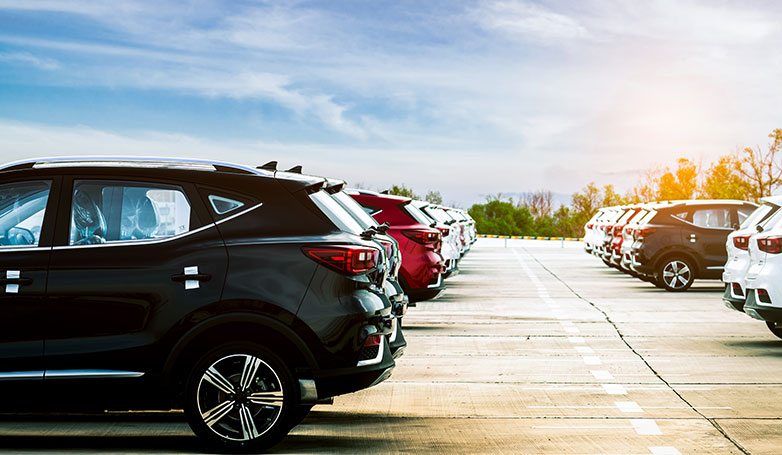
Most concrete parking stops are precast, which means that they are manufactured in one piece with molding and left to set and dry prior to turning out. They often have inner steel rods integrated for greater strength, but this also contributes to their already large amounts of weight.
There are various concrete mixes, based on the manufacturer, to obtain the longest – lasting blend. When you are considering parking stops, you may likely think of concrete parking stops installation, but sadly, concrete mostly struggles to hold up with time and can quickly crack and chip.
The Advantages and Disadvantages of Adding Parking Stops to Your Lot
Properly used parking stops can offer your parking lot or garage a good deal of utility. Sadly, many lots feature parking stops used at awkward times or poorly mounted, which contributes to a lot of discomfort for drivers on the lot who see more harm coming from the stops than good.
The below are some essential things to consider, ensuring that you get the best possible outcome if you are considering installing parking stops to your property:
Advantages
A parking stop that is being appropriately utilized should be in place to prevent more significant harm from happening than the parking stop would trigger on a vehicle that strikes it. There are three basic conditions in which the installation of a parking stop is incredibly beneficial:
- Installing a parking stop when a parking space is up against a wall minimizes the likelihood of a vehicle hitting the wall. This offers protection to the vehicle, the building, and any person inside the building.
- Permanent structures, such as metal poles, are often protected by parking stops. If the pole is robust, it can create immense damage to the vehicle or elements connected to the pole. Hence, installing stops is often beneficial.
- Concrete parking stops installation is an important safety feature to decrease the risks of a vehicle unintentionally striking a person when a parking space nears a pedestrian walkway.
Disadvantages
The primary worry when it comes to the installation of parking stops is a potential error during the installation process.
- Parking stops that are poorly aligned can pose more risk than they can prevent. Laying stops with narrow gaps between them produces a pedestrian lane that is too small, which is a hazard.
- Another thing that poses a safety risk is choosing the wrong size for your stops. While it is almost certain that too big stops will decrease pedestrian access, a parking stop that is not wide enough for the anticipated vehicles may not stop the vehicle appropriately.
FAQs about Concrete Parking Stops Installation
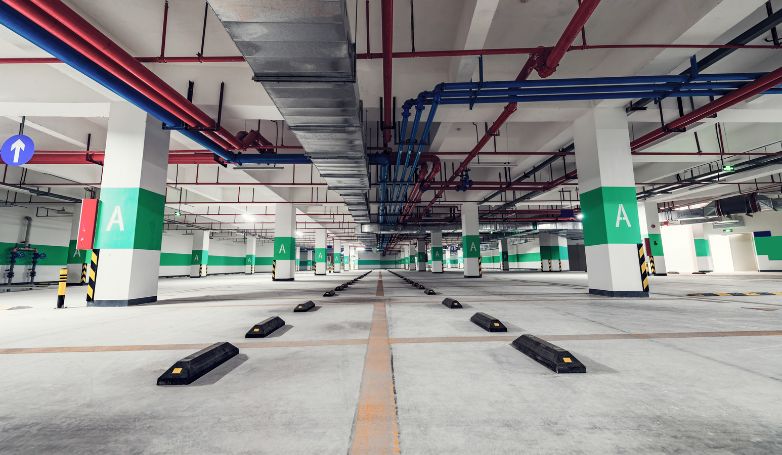
Dive into a comprehensive exploration of frequently asked questions and detailed answers surrounding the intricacies of installing concrete parking stops, providing valuable insights into the various aspects of this crucial process.
How do you install a parking stopper?
Installing a parking stopper involves several steps. First, ensure the surface is clean and level. Position the stopper at the desired location and mark the anchor points. Drill holes for anchors, insert them, and secure the stopper in place using appropriate tools. Double-check alignment and ensure a secure fit for effective parking guidance.
How do you anchor concrete parking blocks?
Anchoring concrete parking blocks is crucial for stability. Start by marking anchor points on the surface. Drill holes corresponding to these marks and insert anchors securely. Place the concrete blocks over the anchors and tighten them down, ensuring a strong and stable connection. Proper anchoring prevents shifting and ensures long-lasting durability.
What are concrete parking stops called?
Concrete parking stops go by various names, including wheel stops, parking curbs, or bumper blocks. These terms are often used interchangeably to describe the structures placed at the end of parking spaces to prevent vehicles from overhanging or encroaching onto sidewalks, landscaping, or adjacent areas.
How do you install wheel stoppers?
Installing wheel stoppers follows a similar process to parking stoppers. Begin by selecting the appropriate location and marking anchor points. Drill holes for the anchors, place the wheel stoppers over them, and secure them tightly. Confirm proper alignment and spacing to ensure effective delineation of parking spaces and protection of surrounding areas.
What is the distance between parking wheel stops?
The ideal distance between parking wheel stops depends on factors such as the size of vehicles and the layout of the parking lot. Generally, a standard spacing ranges from 6 to 8 feet, allowing for effective vehicle positioning and maximizing space utilization. Consider local regulations and specific project requirements when determining the optimal distance between parking wheel stops.
Conclusion
Parking stops are mostly used in commercial and industrial parking lots (both small and large). They are vital because they prevent vehicles from colliding with other cars and with buildings, gardens or disrupting pedestrian lanes.
Some concrete parking stops can not endure the elements outside; hence, they are best suitable for indoor use only. The first step in the parking stop installation is to select the correct stop for the job. There are also various types of methods of installation to consider.
You can hire a professional installer to efficiently get the job done for you if you are not sure what type of parking stops to choose for your business parking lots.

